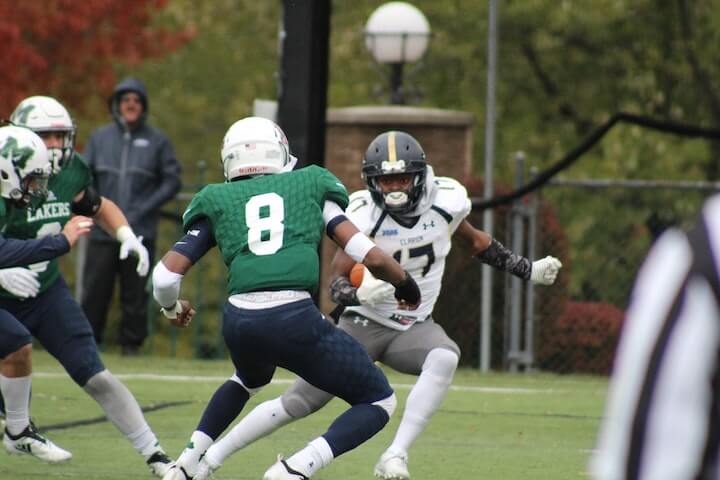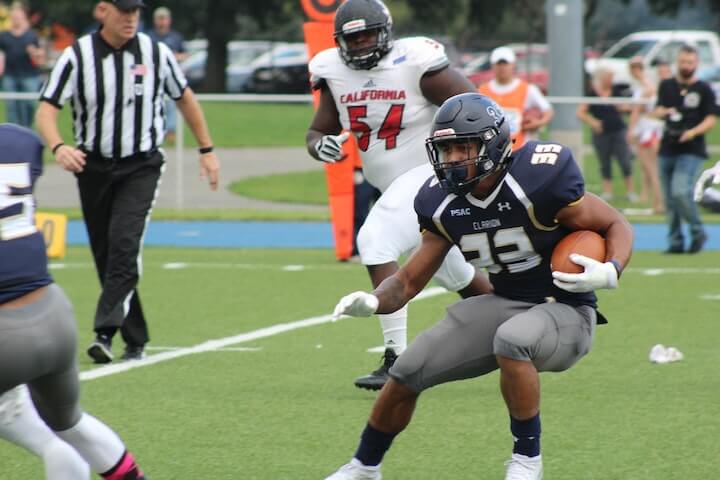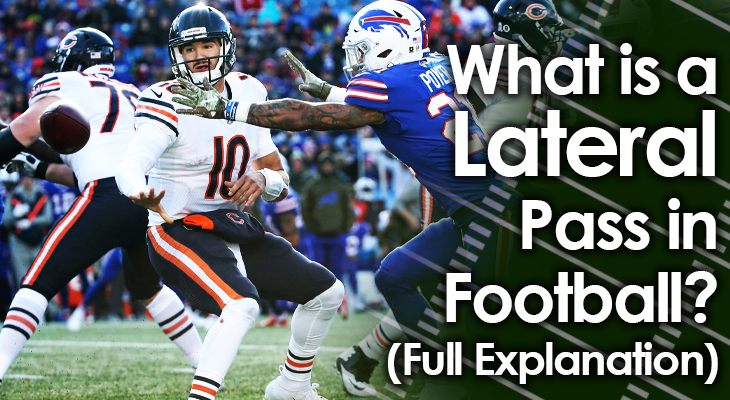When teams are desperate late in games, you might see players throw the ball around the field in hopes of scoring a miracle touchdown.
Some of the most famous moments in football history played out this way, including the "Miracle in Miami" as well as the "Music City Miracle."
Teams execute a lateral pass downfield as a way to transfer the ball from one play to another when they're beyond the line of scrimmage.
Below, we'll look into what a lateral pass in football is so that you understand how teams are able to do it.
What is a Lateral Pass in Football?
Once the ball is past the line of scrimmage, different rules apply for how players can transfer the ball to each other.
A legal way to do this is by using a lateral pass.
A lateral pass is basically a "pitch" from one player to another.
This is a legal way that players can transfer the ball from one player to another once they've advanced the ball past the line of scrimmage.
The lateral pass must go backward rather than forward as it travels from one player to the next. If this happens, then the play will still be live.
Can Players Throw the Ball Backward?
Once ball carriers are beyond the line of scrimmage, they may toss the ball to another player on their team as long as it goes backward.
In other words:
The offense may transfer the ball from one to another in any way they want, as long as the this 'transfer' happens backward.
This could be an underhanded toss -- like a quarterback would do on a sweep running play. Or, it could be a full-blown overhead pass -- like a quarterback would do on a normal passing play.
How the ball gets from one player to the next is not the important factor here. It's whether the ball traveled backward or not.

What Happens if the Ball Hits the Ground?
Another big difference between a forward pass and a lateral is what happens if the ball hits the ground.
On a forward pass, if the ball hits the ground before a receiver obtains possession, it's ruled an incomplete pass.
The play will stop at that point, and the down will move onto the next one.
If the ball hits the ground on a lateral, something much different happens:
Since possession has already been established, any time the ball hits the ground after getting advanced beyond the line of scrimmage, it's considered a fumble.
So, if a player attempts a lateral pass to another member of his team but it falls on the ground, it will be just like any other fumble.
It will be a "live" ball, and whoever recovers it will get possession.
This is why laterals are such risky plays!
Aside from potentially getting intercepted by the defense at every transfer, you also run the risk of fumbling the football away.
Is There a Limit to the Number of Lateral Passes Allowed?
There is no limit to how many times a team can lateral pass on a play.
The play will continue on until either the defense makes a tackle, a ball carrier goes out of bounds, the football travels out of bounds, the other team recovers a fumble, or the team scores a touchdown.
This is what makes lateral plays so exciting.
A team with possession that needs to score a touchdown as time expires to tie or win the game will just continue making lateral passes so they can try to keep the play alive.
The game will be over if they get tackled or they fumble the ball away, which is why they need to do whatever they can to keep the play going.
This is also why teams don't really lateral the football unless they're in a desperate situation.
The play is simply too risky in most cases to even try.
What Happens if a Lateral Goes Forward?
Once a ball carrier takes the ball beyond the line of scrimmage, the rules of the lateral now take effect.
The offensive player can lateral it to another teammate as many times as he wants, and however he wants, as long as the ball travels backward.
"But what happens if the ball travels forward?"
There are cases where the offensive player will try to lateral the ball backward, but it actually ends up going forward.
When this happens, the offense gets called for a penalty -- an illegal forward pass.
It happens any time an offense makes a forward pass from beyond the line of scrimmage.
The result of the penalty is a loss of 5 yards from the spot of the last play.
Of course, this penalty often doesn't matter in the case of multiple laterals, as the game will be over at that point anyway.

Conclusion
A lateral pass in football is a backward pass from one player to another that happens beyond the line of scrimmage.
This play is completely legal as long as it meets the requirements above.
If, however, a player throws the ball forward after they've crossed the line of scrimmage, then their team will receive an illegal forward pass penalty.

